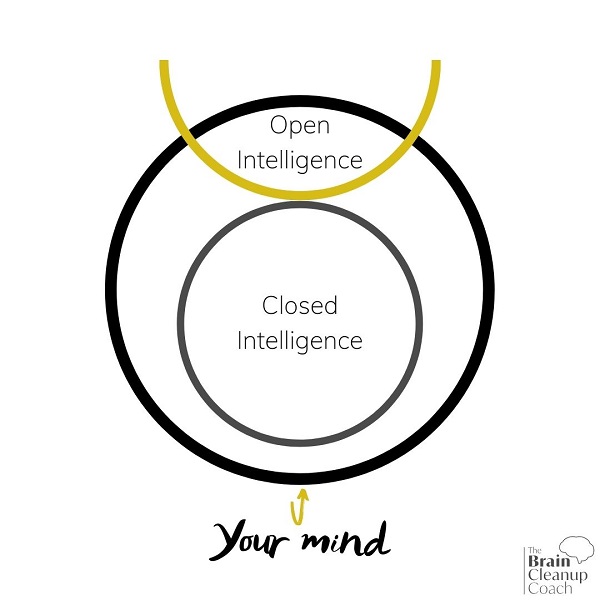
5 Mindset tools to lessen fear
Links in some blog posts may earn a commission for The Brain Cleanup Coach.
It’s normal to feel fear.
In fact, without it a safe existence could be pretty darn hard.
In my last blog post I introduced you to the concept of Open and Closed Intelligence. (For an explanation, click here to read that post.)

I explained that Closed Intelligence is where our quick, fearful judgments originate. Open Intelligence is where consideration, deliberation, and intentional reaction is formed.
It can be hard to rise into Open Intelligence when confronted with fear, because fear is meant to happen quickly. But what if your mind and body are producing fear in response to something that really isn’t dangerous, and the fear is stopping you from doing something you want to?
The key here is to train your brain to regularly utilize that Open Intelligence space, so even when Closed Intelligence creates a quick reaction, you can intellectually consider the reaction, and make a choice as to whether or not it is useful.
1. Meditation
I will always recommend meditation first, but this is the long haul recommendation. This is a skill to practice daily for the rest of your life. And hopefully that’s a long time! Here’s why meditation is my top recommendation: imagine a parent with a toddler at a playground, and the parent knows the toddler needs to stay in a specific area for its own safety.
The toddler, being a natural explorer, or course wants to constantly leave the area. The parent, having wisdom, corrals the toddler back to where they need to be time and time again. Anyone who has had children or knows people with small children can relate to this.
This is kind of what you’re doing when you meditate. You choose a point of focus, often the breath or a repeated mantra, and this is like the designated area for the toddler (your brain). Being naturally curious and active, your brain will want to wander. During meditation you bring your brain back to the point of focus time and time again, as many times as needed during the meditation session.
Yes, this can be aggravating when first starting a meditation practice, because one of the active thoughts your brain might wander to is “you’re doing it wrong.” Not so. Meditation is just the act of coming back to focus. And in a moment when fear rises up, having the ability to refocus on what is actually true in the moment is a powerful way to lessen the fear.
2. Role Playing
Not THAT kind of role playing, but hey, you do you.
The role playing I’m referring to is allowing yourself to step into the shoes of someone else through your imagination.
One I’ve been playing with a lot lately is thinking about how the world’s most graceful woman would do something. And when I say something I mean anything. If I were the worlds most graceful woman how would I sit, stand, eat, go to the bathroom, type a sentence… etc.? This came from a very specific exercise I’ll list next, but it’s been a fun challenge for my mind to think about how this woman would gracefully move through her life, including all the daily, mundane stuff.
You may be asking how is this connected to fear, and it comes back to mindfulness. The more you can train your brain in focused mindfulness, the better you become at observing what your Closed Intelligence creates as a Quick Reaction, and on a regular basis you’ll start to use your Open Intelligence to opt for Considerate Reaction. A reaction that is thought out and deliberate.
So here’s a role to imagine acting out: how would the most courageous person in the world act? Not only in fearful situations, but in everyday life. Would they walk with good posture and their head held high? Would they look people in the eye? Would they procrastinate, or would they tackle anything they needed to do in that very moment? Challenge yourself to really step into this role in your imagination. You might find that you actually start to feel like this person from time to time.
3. Put the dishes away quietly
This is a very specific one, but it’s a great exercise in self awareness and mindfulness. I came up with this one day when I was upstairs in my house and my husband was unloading the dishwasher downstairs, and I noticed just how loud putting dishes away can be. There’s the tinkling from the silverware, clanging from the plates and bowls, and thuds as cupboards and drawers close. I knew that when I put dishes away it wasn’t any quieter, and I realized this was because typically when we perform a task like that, our mind wanders (hello toddler on playground).
So the next time I put dishes away, I challenged myself to do it as quietly as possible. It still made plenty of noise, but I controlled it where I could, and was very present with the task because I had to be.
The benefit of doing something like this is, once again, creating focus. The more skilled you become at mindful focus, the more skilled you become at controlling your own mind. And mind is where fear begins. This is an easy, regular challenge you can give yourself, and it can spread out into other areas of your home life. Wherever you create noise or movement, you can challenge yourself to do it just differently enough that you have to stay aware and present.
4. See your brain as a storyteller
You know what usually comes right along with fear in your mind? A story. Your brain creates a story to try and prepare you for a possibility. There are two things to recognize about this:
- the story isn’t true (it could come true, or it could not)
- the story is just ONE possibility
Your brain makes an educated guess that relies on what is programmed into Closed Intelligence to make the story up. This sets up an expectation, so you can then create a reaction to try and manage an imaginary scenario. Again, the scenario might have a chance of coming true, but so often something entirely different happens.
If you can start to relate to your brain as a storyteller, as essentially a biological computer in your skull that is going to pump out information as a SUGGESTION in the form of a story, you can take agency over what happens in the moment following fear. Closed Intelligence (in an effort to help) is going to tell you one thing, but Open Intelligence can help you see all the other options open to you, including neutralizing the situation to a point that you may be able to recognize that there is nothing to fear.
5. Accept the fact that you don’t know
This ties into the storyteller point, your brain will try and convince you that you know. The story will seem so real and like it truly is the only option. This could trap you in your fear.
But the truth is you don’t know. You don’t know what will happen. Yes, you can make an educated guess. You can even listen to your intuition. But you never truly know what is going to happen until it actually happens. Your brain will want to convince you that you do know, and it will do this through bias. If you are biased to be fearful about something, of course you will find the reasons for that fear, even if you have to contort reality a bit to prove it.
You don’t know. That in and of itself can be a little disconcerting, but what it truly proves is how much is possible aside from just what your brain offers you.
Are you curious about controlling your fear responses, and want some help doing it? Coaching can be a powerful tool in this effort. Click here to book a complimentary consultation with me.




